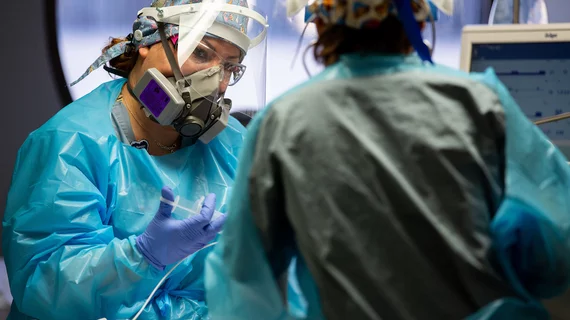An updated look at what cardiologists know about heart damage among COVID-19 patients
More than 25 months after COVID-19 was officially categorized as a pandemic by the World Health Organization, researchers are still working to learn as much as possible about the cardiovascular side effects associated with infection.
A new analysis published in Circulation [1], for instance, includes an updated look at acute myocarditis among patients hospitalized with COVID-19 during the first 14 months of the pandemic. The study’s authors explored data from nearly 57,000 hospitalized COVID-19 patients who were treated from February 2020 to April 2021 in the United States or Europe.
Overall, 54 of those patients had “definite or probable” acute myocarditis as seen on a myocardial biopsy and/or MRI results. This equals an estimated 2.4 cases of acute myocarditis per 1,000 hospitalized patients.
The average age of these patients was 38 years old, 61% were men and 76.5% were non-Hispanic white. Approximately 20% of them needed mechanical support for circulation, or died while hospitalized.
“This analysis indicates that, although rare, hospitalized patients with acute myocarditis associated with COVID-19 infection have a much greater need for intensive care unit admission, in up to 70.5% of the cases, despite the average age of the individuals in the study being much younger than expected at 38 years old,” co-lead study author Marco Metra, MD, a professor at the Institute of Cardiology and in the department of medical and surgical specialties, radiological sciences and public health, at the University of Brescia in Brescia, Italy, said in a statement.
These results, the authors added, represent many patients who were treated before COVID-19 vaccines were readily available.
Heart issues among children and young adults with COVID-19
The American Heart Association (AHA) has also shared a new scientific statement focused on diagnosing and treating cardiac complications among children and young adults with a confirmed COVID-19 diagnosis.
The full statement, also published in Circulation [2], includes updated information on multisystem inflammatory syndrome in children (MIS-C), heart rhythm abnormalities, heart inflammation and other “uncommon” cardiac side effects associated COVID-19 in this younger patient population. The authors also noted that returning to sports and other physical activities after a full recovery is safe, though additional screening may be helpful when evaluating younger patients who experienced more severe symptoms.
In addition, the statement’s authors called for more research on this topic.
“Two years into the pandemic and with vast amounts of research conducted in children with COVID-19, this statement summarizes what we know so far related to COVID-19 in children,” writing group chair Pei-Ni Jone, MD, a specialist with Children’s Hospital Colorado in Aurora, Colorado, said in a separate statement. “We focused on the effects of this virus for those with congenital or other heart disease, as well as the latest data about the potential association of the COVID-19 vaccines with heart complications in children and young adults. While there is a lot we know, this public health emergency needs ongoing research to understand the short- and long-term impacts on children.”
Related COVID-19 Content:
ACC consensus explains what cardiologists should look for in long COVID-19
VIDEO: Vaccines boosted survival among STEMI patients with COVID-19
COVID-19 linked to a higher risk of diabetes for at least 1 year
Risk of vaccine-related heart damage after booster shot lower than it was after first 2 doses
Telecardiology during the COVID-19 pandemic showed cardiologists another way to treat patients
COVID-19 vaccines safe for patients with a history of heart damage
Losartan fails to improve lung injuries in hospitalized COVID-19 patients
References:

